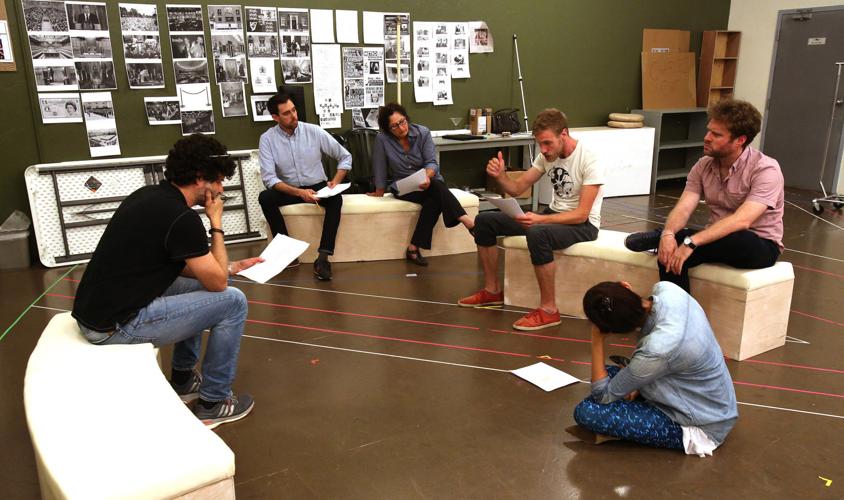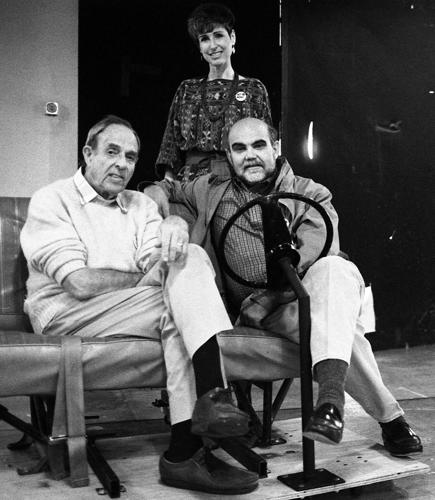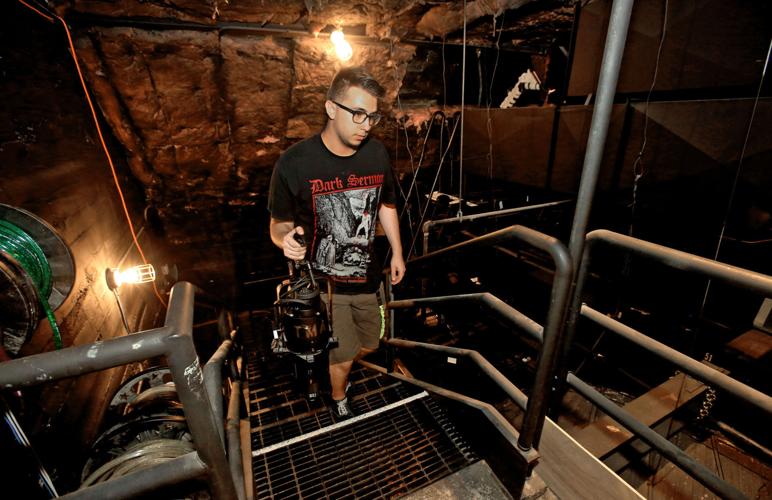Survival isn’t easy for a theater company.
Artistic challenges, money woes, contentious board/staff/artists relationships. There is so much that pushes against the creation of art.
Some fully-professional theater companies don’t make it — San Jose (Calif.) Repertory Theatre closed in 2014 after 34 years of staging plays; Actors Theater in Phoenix closed that same year, after 29 years.
Arizona Theatre Company hasn’t escaped the woes. But it has managed to survive, though that has been in question a few times since its founding in 1966.
A decade-by-decade look at the company as it prepares to launch its 50th season next week:
1966-76
A band of theater-loving citizens decides Tucson needs a company that has ambitions to grow, become fully professional and bring the Old Pueblo New York-worthy plays. The company is embraced by the city.
- 1966: In November, Sandy Rosenthal and a group of like-minded citizens announce plans for the Arizona Civic Theater. It will have a year-round season, with productions for children. It stages its first plays the following summer.
- 1967: A $3,500 grant from the Arizona Commission on the Arts helps launch the company. “Generation,” its first production, opens in the Santa Rita Hotel’s basement space in July. Rosenthal, the founding artistic director, directs.
Twenty-year-old Tucsonan Molly McKasson, a theater major on summer break from Northwestern University, snags the lead. “It was a wonderful experience,” says McKasson, who went on to perform in more plays for the company. (Eventually she left theater and became a member of the Tucson City Council.)
Rosenthal’s energy propelled the company forward, she says. “He would talk to all of us about the company and how it would be professional. He was high energy and creative, and full of so much passion for theater and for the people making theater. … To me, Sandy Rosenthal is the maker, the mover, the shaker. He made it happen. People talked about it, but Sandy made it happen.”
The company’s second production, “The Mousetrap,” in August of ’67, features uniformed sheriff deputies serving as ushers for the murder mystery. All the plays that summer sell well and receive good reviews.
A new season, running from November to May, is announced. Four plays, plus another three for children and another three called “off off Broadway.” Tickets are $10 for the four main productions, $1.50 for the others. Before that season begins, the downtown Santa Rita builds the theater a new stage.
- 1968: The company asks the city to plan for a theater in the new Tucson Community Center, slated to be completed in 1971. A five-play season is scheduled. In that same year, Rosenthal publicly talks about his goal that ACT become a fully-professional theater. The production of Arthur Miller’s “A View From the Bridge” features the theater’s first Equity actor, Antony Carbone, who has performed in films and plays around the country.
- 1970: In September, the company leaves the Santa Rita and moves into a downtown building once occupied by the Salvation Army. The theater’s crew refurbishes it and in October, the season opens with “You Know I Can’t Hear You.”
- 1972: The company becomes fully professional, which ups the quality of everything from costumes to the actors. At the same time, artistic director Sandy Rosenthal responds to complaints that the company ignores local talent when it hires actors from out of town. It’s a complaint that is still heard today. This is also the year that ACT moves into the Leo Rich Theatre at the TCC.
- 1975: Money woes surface and a plea goes out for donations. If $50,000 isn’t raised, “The theater may close” a board member tells the Star.
- 1976: David Hawkanson is named ACT’s managing director. It is also the year that the company stages “‘Sizwe Bansi is Dead,” just four years after Athol Fugard’s play about apartheid premiered in the playwright’s home nation, South Africa. The production gives the theater a much needed financial boost. ”It’s crazy,” Hawkanson said in a 1988 interview. “We were on the verge of going under. I remember calling around to get a director and people kept telling me that I was crazy to do this particular show at this particular time.”
Crazy smart, as it turns out. “On a cash flow basis, it was the show that saved us,” Hawkanson said.
It also solidifies ACT’s reputation as a company willing to take artistic risks
- 1977: “Vanities” is the first show the company takes to Phoenix. By 1983, full seasons are presented in both Phoenix and Tucson.
- 1979: The company changes its name to Arizona Theatre Company. Health concerns force Sandy Rosenthal to step down, and Mark Lamos becomes artistic director for a short stint. He goes on to make a name for himself as a director on Broadway and around the country.
- 1980: Gary Gissleman is named artistic director. He plans seasons that are a mixture of fluff and meat. His first full season out, ’81-82, included both Beckett’s “Waiting for Godot” and Donald L. Coburn’s “The Gin Game.” You couldn’t get much more disparate plays.
- 1985: Hawkanson steps down and Richard Bryant from Washington, D.C.’s prestigious Arena Stage becomes its managing director. Less than a year later he leaves, calling it a “no-fault divorce.”
1986-96
The decade begins with great hope, which quickly sours. There are changes in top management, internal fights, money struggles. It is also a decade when ATC begins producing original works and more diverse, often daring, fare.
- 1986: Gisselman shows he has the guts to challenge artistic expectations and commit to some riveting theater. The 1986-87 season, dubbed the “American Dream” season, includes the disturbing “The Marriage of Bette and Boo,” the rich-with-foul-language-and-big ideas, “Glengarry Glen Ross,” and the thoughtful, important, “A Delicate Balance.”
It is riveting, exciting, meaty. And a flop.
- 1987: Susan Goldberg, a librarian with no theater experience, is named managing director.
- 1989: The company is still struggling as a result of the “American Dream” season. An emergency fundraising campaign is launched to raise $1 million. If it fails, ATC will close. And internal strife doesn’t help matters. Goldberg is forced to resign, and George Rosenberg, a member of ATC’s board, becomes interim CEO. Once the company is out of trouble, Robert Alpaugh is named managing director.
- 1990: The ‘90-91 season opens with “Amadeus” in ATC’s new home, the Temple of Music and Art. This is also the season that the company announces it will produce one new play a year — a significant step for a theater company. First up is “The Holy Terror” by one of Britain’s most revered playwrights, Simon Gray. Upping the prestige of this production: Gray is willing to travel to the desert to direct.
- 1991: Amid talk of animosity between Alpaugh and Gisselman, Gisselman resigns. He has been with the company 11 years.
- 1992: Early in the year, David Ira Goldstein is named artistic director.
- 1993: This is the first season Goldstein picks. A highlight is “M. Butterfly,” a Tony-winning play that still sticks in Goldstein’s memory. “It is one of the best things we’ve ever had on our stage,” he says. It is based on a true story about a French diplomat who is convicted of treason for passing secrets to his mistress, a Chinese opera star who is a spy. And a man. The play included male and female nudity. That prompted the Tucson Police Department to demand that no one under 18 be allowed to see the play.
That year also saw two productions that were so painful they are hard to forget: Chekhov’s “The Seagull,” and Michael Michaelian’s “Fertility Rights.” ATC gave “Fertility Rights” its world premiere, and we can not find any record that it has ever been restaged. While the performances are fine, the script is downright bad. “The Seagull” had the opposite problem: the script is brilliant but this production, directed by film star Olympia Dukakis, is fat with foul acting.
- 1995: ATC begins a long relationship with playwright Steven Dietz with the world premiere of his adaptation of Bram Stoker’s “Dracula.” Dietz will eventually premiere five plays here. “David Ira and his great staff and stage managers would rally the entire theatre around some play of mine that had never been done, had no track record, offered no guarantee other than a chance to tell a new story or a known story in a new way,” Dietz says in an email. “To do the work (and revise the work!) — and to do it with masterful artists and the full support of a major theatre — was a great joy.”
In June of ’95, Robert Alpaugh steps down after six years as managing director. Three months later, Jessica Andrews, who has a deep background in theater management takes his place.
1996-2006
This decade is rich in Shakespeare, with five of the Bard’s plays staged. Only six had been produced in the previous 30 years. It’s also a decade that brings a number of works by August Wilson, plays in repertory, and a relationship with London’s Royal National Theater.
- 1996: ATC stages August Wilson’s “Seven Guitars.” The company has done only one other by Wilson (“Fences” in 1990), one of the 20th century’s most important playwrights. The Pulitzer Prize-winning Wilson wrote eloquently and feverishly about the African-American experience in the 20th century.
- 1997: ATC hosts The Royal National Theatre’s production of “Othello” in Phoenix. While Tucson missed out on that, the relationship forged with the London-based company leads to the National bringing “Hamlet” here in 2001. That production stars Simon Russell Beale, one of England’s bravest and greatest actors.
- 2000: ATC’s continuing commitment to staging newer works along with classics is clear with back-to-back productions: Shakespeare’s “As You Like It” and the 1999 Tony winner “Side Man” by Warren Leight.
- 2002: The end of the 2001-02 season gives theater lovers an adrenaline rush: ATC’s first Rep Fest. Three plays — edgier ones that bring in a more diverse audience — are staged. The hope is that the concept can be repeated in future seasons.
- 2005: Off-Broadway bound “Hank Williams: Lost Highway” packs in audiences for its three-week run at the Temple.
- 2006: “Sherlock Holmes: The Final Adventure,” opens. It is ATC’s sixth world premiere of a Steven Dietz’ play. Those plays continue to be staged by theater companies around the country.
2006-2016
While the decade starts out with enthusiasm, ATC can’t escape the recession that rocks the world. It tries to rein in costs by increasing co-productions with other companies and staging plays with smaller casts. This is also a decade that sees a revolving door of managing directors, money woes, and a theater company that just won’t give up.
- 2006: Jessica Andrews is named executive director of ATC, and Kevin Moore its managing director. Andrews will concentrate on the company’s major gifts campaign, which has a goal of raising $2.9 million.
- 2007: The Rep Fest is back, with three plays, including a rockin’ bio-play about Janis Joplin, “Love, Janis.” This is the last rep fest staged by ATC.
- 2009: Andrews retires after nearly 14 years with the company. ATC’s finances stabilized during her tenure, and the education program expanded. Her steady hand also contributed to ATC’s growing reputation around the country.
The 2009-10 season opens with an adaptation of Khaled Hosseini’s “The Kite Runner.” Director Goldstein works closely with Hosseini on the adaptation; it is one of most most riveting, visually thrilling plays ATC has ever staged.
- 2010: Kevin Moore, who has been with ATC for 10 years and its managing director for three, steps down to take a job in New York City. He leaves the company with a manageable operating deficit of about $200,000.
- 2011: It takes a year and a national search before ATC finds its new managing director, Mark Cole, who comes to the company from Miami City Ballet.
- 2013: David Ira Goldstein announces his resignation. The board is fractured and employee morale is low. After a drastic reduction in staff and a deficit that balloons instead of dwindles, Cole steps down. Andrews comes out of retirement to manage the company, and Goldstein agrees to stay until ATC stabilizes.
- 2014: A $1 million deficit looms; a donor gives $200,000 for a matching campaign.
- 2014-16: The turmoil in the office doesn’t impact the quality of performances. Among the works ATC stages are the gutsy, funny and provocative “Venus in Fur,” an edgy “Romeo and Juliet,” and a powerful production of Wilson’s “Fences.”
- 2015: A management consultant is brought in to help launch a search for artistic and managing directors. Instead, the consultant decides that ATC first needs to get its house in better order. William Russo, who has worked with the American Repertory Theater and New York Theatre Workshop, comes on as interim managing director.
- 2016: Despite good ticket sales, ATC has yet to fully recover from the turmoil and deficit of a few years before. In late June it announces it has two weeks to raise $2 million or it will close. That period is extended two weeks. After furious fundraising efforts that involve board members, politicians and donors in both Tucson and Phoenix, the money is raised. The 2016-17 season, the company’s 50th, will go on as planned.

















